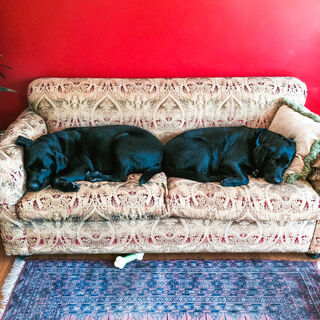Anxiety
Does Another Dog in the House Reduce Separation Anxiety?
Videos were used to record anxiety-related behaviors of dogs left home alone.
Posted November 16, 2021 Reviewed by Vanessa Lancaster
Key points
- Most dogs showed low vocal and physical activity, independent of time being alone at home.
- Physical activity was higher when more than one dog was in the household, primarily in the first hour of separation.
- Male dogs in multi-dog households were more likely to bark and vocalize than were canines in single dog households.

Science has a way of showing us that much information that we know about dog behavior and solutions to common canine behavioral problems may not actually be true.
The latest data suggests that a popular remedy for separation anxiety in dogs may fall into that category.
Separation Anxiety
A recent survey showed that 73 percent of dog owners normally leave their pets at home while going to work. However a goodly percentage of these dogs do not remain quietly in their house when the owner is away. Nearly one out of two dog owners report that their dogs currently, or sometime in the past, showed problematic agitation and anxiety when the owners left the home.
Most typically the dogs responded with prolonged bouts of barking, whining, whimpering or howling. Some engaged in destructive behavior, such as chewing on furniture, curtains or shoes, or scratching and tearing at the walls or doors. Others, who normally were housebroken, return to urinating or defecating inappropriately when their owner was away. This behavior syndrome is normally referred to as separation anxiety.
The problem of separation anxiety is regrettably common. One study of medical records of a veterinary clinic found that 14.4 percent of their behavioral caseload involved separation anxiety and it turned out to be the second most common behavior disorder after problems with aggression.
A Popular Solution to the Problem
If an individual shows up requesting help for a dog who has symptoms of separation anxiety, one of the most common recommendations that a canine behavior specialist will offer is that this client should consider getting another dog to keep the first dog company. The rationale behind this is quite simple. The argument goes, if the dog is showing anxiety because he or she is feeling isolated and alone, then obviously simply providing them with a companion should relieve the loneliness and solve the problem. The difficulty with this solution is that little evidence shows that dogs are less anxious in a multi-dog household than being by themselves has appeared in the scientific literature.
Watching Dogs Left Home Alone
A team of researchers led by Gerrit Stephan at the Academy for Animal Naturopathy in Dürnten, Switzerland, decided to test directly to see if dogs are calmer and show less agitation when their owner is away from home they are currently living with another dog. This study involved setting up three video cameras in each home. These were pointed to the places where the dogs usually stay during separation. The sample consisted of 32 dogs in single dog homes and 45 dogs in multi-dog households, all of whom were left in the house alone as part of their usual routine.
The Video Record
On the whole, the data revealed that dogs were not very active when their owner left. They predominantly lay quietly relaxing in their preferred places. For 22 percent of the time dogs showed some minor activity (raising their head, sitting or standing), and it was for less than two percent of the time that their activity levels reached any high level like running around.
Overall there were no significant differences in activity between female and male dogs and their neuter status made no difference. In general, male dogs seemed to show the greatest separation anxiety, and they are the ones that are most likely to be found lying near the exit door. The likelihood that they are in that location increases with the duration of separation.
Does a Canine Companion Reduce Anxiety?
Actually there was a clear significant difference between whether or not dogs were living alone or in a multi-dog household — however it was not in the direction that traditional beliefs might predict.
When it comes to vocalizations, overall female dogs bark less when home alone. They are noisier if there was another dog in the house. However the highest levels of barking and other vocalizations are found in the male dogs that are in a multi-dog household. Thus contrary to expectations that a dog with a companion will be calmer, having another dog in the house seems to actually increase separation anxiety symptoms. These signs of anxiety are greatest in the first hour after the owner leaves, but then seem to taper off over time.
A Solution That Failed
So what did the authors conclude about the traditional advice which suggests that adding another dog to the household may solve separation anxiety? They say,
Since dogs under single-dog conditions show more resting and less vocalizations, we could not support the view that familiar conspecifics could facilitate coping with separation stress. Although further research is needed, our data suggest rather the opposite.
In other words, dogs living with a pal are not calmer than dogs living alone. Once again, the scientific data does not support the "obvious," popular, and simple interpretation of how dogs should behave.
Copyright SC Psychological Enterprises Ltd. May not be reprinted or reposted without permission.
References
Gerrit Stephan, Joachim Leidhold and Kurt Hammerschmidt (2021). Pet dogs home alone: A video-based study. Applied Animal Behaviour Science 244, 105463




